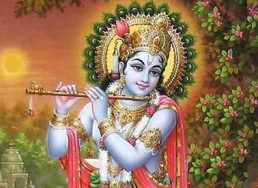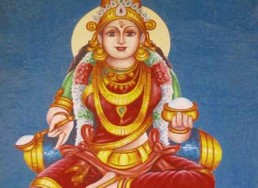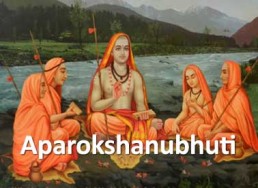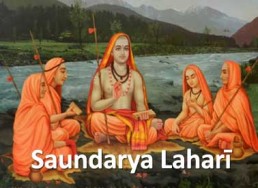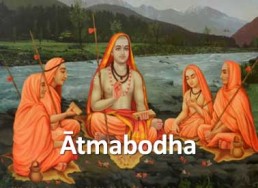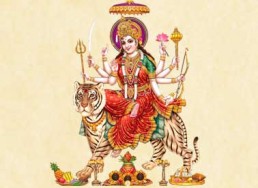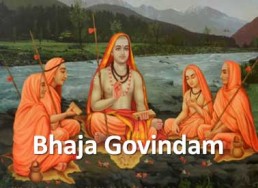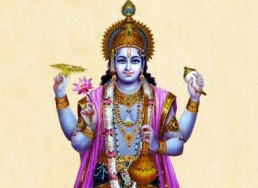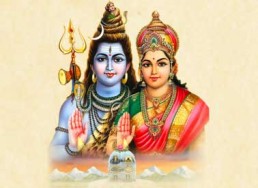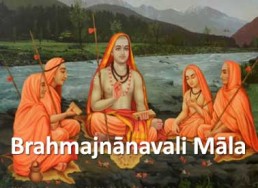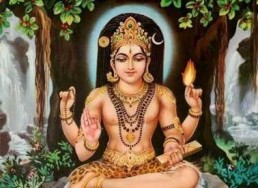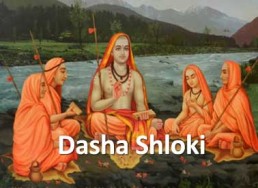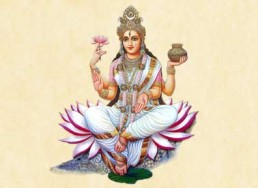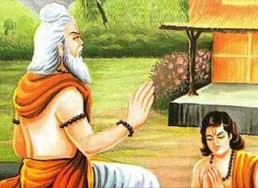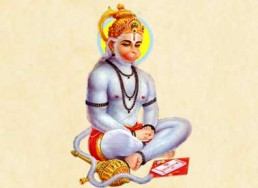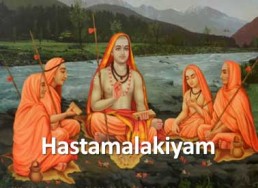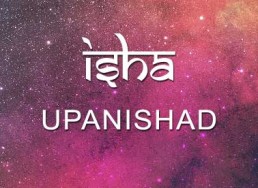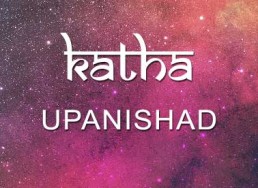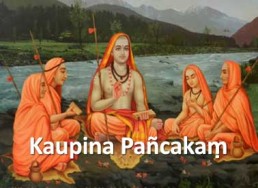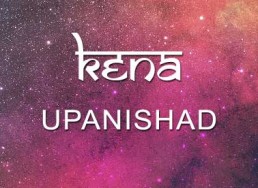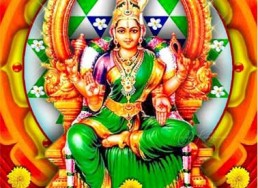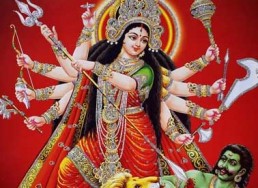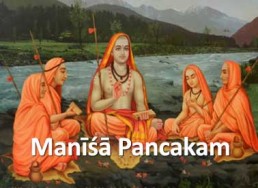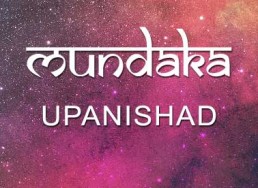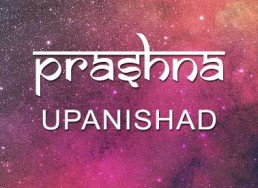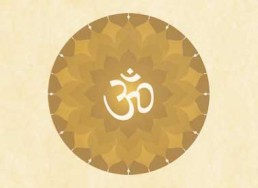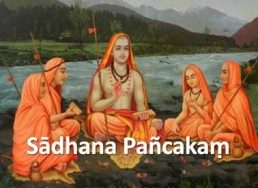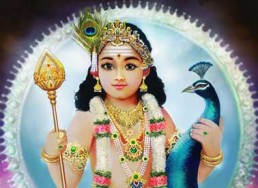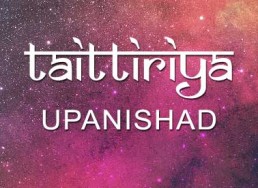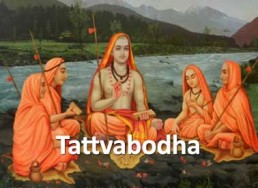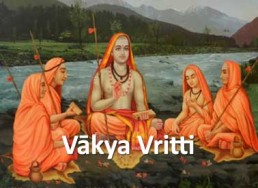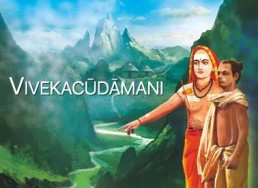Nirvana Shatakam
न च श्रोत्रजिह्वे न च घ्राणनेत्रे ।
न च व्योम भूमिर्न तेजो न वायुः
चिदानन्दरूपः शिवोऽहम् शिवोऽहम् ॥१॥
na ca śrotrajihve na ca ghrāṇanetre .
na ca vyoma bhūmirna tejo na vāyuḥ
cidānandarūpaḥ śivo’ham śivo’ham ||1||
Neither am I the organs of hearing (ears), nor that of tasting (tongue), smelling (nose) or seeing (eyes),
Neither am I the sky, nor the earth, neither the fire nor the air,
I am Shiva, the supreme auspiciousness of the nature of consciousness-bliss.
I am (Shiva) the auspiciousness.
न वा सप्तधातुः न वा पञ्चकोशः ।
न वाक्पाणिपादं न चोपस्थपायु
चिदानन्दरूपः शिवोऽहम् शिवोऽहम् ॥२॥
na vā saptadhātuḥ na vā pañcakośaḥ .
na vākpāṇipādaṃ na copasthapāyu
cidānandarūpaḥ śivo’ham śivo’ham ||2||
Neither am I the seven ingredients (of the body), nor the five sheaths (of the body),
Neither am I the organ of speech, nor the organs for holding (hand), movement (feet) or excretion,
Iam the ever pure blissful consciousness; I am Shiva, I am Shiva,
The ever pure blissful consciousness.
मदो नैव मे नैव मात्सर्यभावः ।
न धर्मो न चार्थो न कामो न मोक्षः
चिदानन्दरूपः शिवोऽहम् शिवोऽहम् ॥३॥
mado naiva me naiva mātsaryabhāvaḥ .
na dharmo na cārtho na kāmo na mokṣaḥ
cidānandarūpaḥ śivo’ham śivo’ham ||3||
Neither do I have passion, nor feelings of envy and jealousy,
I am not within the bounds of dharma (righteousness), artha (wealth), kama (desire) and moksha (liberation) (the four purusarthas of life),
I am Shiva, the supreme auspiciousness of the nature of consciousness-bliss.
I am (Shiva) the auspiciousness.
न मन्त्रो न तीर्थं न वेदा न यज्ञाः ।
अहं भोजनं नैव भोज्यं न भोक्ता
चिदानन्दरूपः शिवोऽहम् शिवोऽहम् ॥४॥
na mantro na tīrthaṃ na vedā na yajñāḥ .
ahaṃ bhojanaṃ naiva bhojyaṃ na bhoktā
cidānandarūpaḥ śivo’ham śivo’ham ||4||
Neither am I bound by sacred hymns nor by sacred places, neither by sacred scriptures nor by sacrifies,
I am neither enjoyment (experience), nor an object to be enjoyed (experienced), nor the enjoyer (experiencer),
I am Shiva, the supreme auspiciousness of the nature of consciousness-bliss.
I am (Shiva) the auspiciousness.
पिता नैव मे नैव माता न जन्मः ।
न बन्धुर्न मित्रं गुरुर्नैव शिष्यं
चिदानन्दरूपः शिवोऽहम् शिवोऽहम् ॥५॥
pitā naiva me naiva mātā na janmaḥ .
na bandhurna mitraṃ gururnaiva śiṣyaṃ
cidānandarūpaḥ śivo’ham śivo’ham ||5||
Neither do I have father and mother, nor do I have birth,
Neither do I have relations nor friends, neither spiritual teacher nor disciple,
I am Shiva, the supreme auspiciousness of the nature of consciousness-bliss.
I am (Shiva) the auspiciousness.
विभुत्वाच्च सर्वत्र सर्वेन्द्रियाणाम् ।
न चासङ्गतं नैव मुक्तिर्न मेयः
चिदानन्दरूपः शिवोऽहम् शिवोऽहम् ॥६॥
vibhutvācca sarvatra sarvendriyāṇām .
na cāsaṅgataṃ naiva muktirna meyaḥ
cidānandarūpaḥ śivo’ham śivo’ham ||6||
I am present everywhere as the underlying substratum of everything, and behind all sense organs,
Neither do I get attached to anything, nor get freed from anything,
I am Shiva, the supreme auspiciousness of the nature of consciousness-bliss.
I am (Shiva) the auspiciousness.
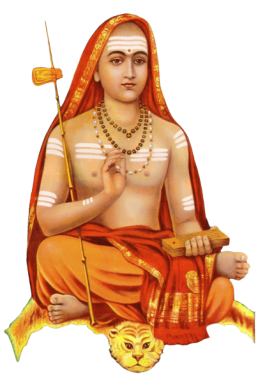
Description
Nirvana Shatkam (Atma Shatakam) of Adi Sankara
Commentary and Notes Translated by S. N. Sastri
Introduction:
Sri Sankara Bhagavatpada has blessed posterity with a large number of invaluable compositions. These can be grouped under three broad categories. The first category, meant for the intellectually most advanced, comprises his commentaries (Bhashya) on the Upanishads, Brahmasutra, and the Bhagavadgita. The second category consists of independent works, known as prakarana granthas, which expound the gist of the Upanishads in simple language. These vary in length from half a verse to one thousand verses. In the third category fall devotional hymns.
Nirvana Shatakam also known as Atma Shatakam is a prakarana grantha consisting of six verses. Prakarana has been defined in the Vishnu Dharmottara Purana thus: “Prakarana is a text which explains some particular aspects of the Sastra and deals with certain secondary questions arising out of the explanations given”.
The instruction emphatically conveyed by the six verses of Nirvana Shatakam is that identification with the body, mind, and senses is the root cause of all sorrow and that it should be given up and one should realize one’s real nature as none other than the supreme Brahman. This realization is what is known as Liberation. One by one, Adi Shankaracharya negates all the usual identifications that we have and repeatedly insists, “chidananda roopa shivoham shivoham.”
Verse 1
1. I am not the mind, nor the intellect, nor the ego-sense, nor the store-house of memories. I am not the ear, nor the tongue, nor the nose, nor the eyes. Nor am I the sky (space), or the earth, or fire, or air. I am the supreme auspiciousness of the nature of consciousness-bliss. I am (Shiva) the auspiciousness.
Commentary: In all these verses the term ‘I’ stands for the pure Atma. The mind is defined thus in Brihadaranyaka upanishad, 1.5.3 – “Desire, resolve, doubt, faith, lack of faith, steadiness, unsteadiness, shyness, intelligence, fear – all these are nothing but the mind”. The idea brought out here is that all emotions are in the mind and not in the Atma. A person identifies himself with his mind when he says, “I desire this”, “I have resolved to do this”, etc. This verse points out that this identification is wrong and is due to ignorance of the fact that everyone is in reality the Atma or self, which is identical with the supreme Brahman. The question arises, why have the intellect, ego-sense and the chittam been mentioned separately, when they are all included in the mind itself? The reason is that, though the mind is only one, it is given four different names in Vedanta according to the four different functions performed by it. This has been explained by Sri Sankara in Vivekachudamani in slokas 95 and 96 as below:
“The one antahkarana or inner organ is known by four different names, manas, buddhi, ahankara and chittam according to the different functions. When the mind cogitates it is called manas. When it comes to a decision it is called buddhi. When it stores memories, it is called chittam. When it identifies itself with each of these functions it is known as ahankara. The manner in which these functions take place can be explained by taking an illustration. I am walking along the road and I see at a distance a person whose gait seems to resemble that of a certain friend of mine, named Raman. I begin to debate whether the person I see at a distance is Raman or not. This function of debating is what is called ‘manas’. When he comes nearer and I am able to see his face clearly, I compare it with the memory of the face of Raman stored in my mind. This memory is ‘chittam’. If I find that the two tally, I decide that he is Raman and I greet him. This function of deciding is called ‘buddhi’. The performer of all these three functions is ‘I’, which is known as ‘ahankara’. The term ‘manas’ is also generally used to denote all these four collectively, when these distinctions are not intended.
By the statement “I am not the mind, etc.”, we are asked not to identify ourselves with these activities of the mind and to look upon ourselves as the pure Atma which is actionless and is a mere witness of the activities of the mind. In this way we will not be affected by the joys and sorrows that arise in the mind. In the Bhagavad Gita, 3.27, the Lord says that all actions are performed by the body, mind and senses, but because of delusion everyone thinks that he is the doer.
A person identifies himself with his body and his sense organs when he says, “I am stout, I am fair-complexioned, I hear, I taste, I smell, I see, etc”. The second line points out that this identification is also wrong and is due to delusion. The body is made up of the five elements, space, air, fire, water, and earth. By denying identification with these in the third line, identification with the physical body is denied.
The last line says that we are none other than the supreme Brahman which is existence-consciousness-bliss. The word Siva should not be mistaken to mean Lord Siva. Those who want to attack Advaita interpret this as meaning that Advaita asks the individual to arrogate to himself the status of God Himself. This is a wrong understanding. The term ‘Siva’ is used here in the same sense as in the Mandukya Upanishad, 7, where it means ‘auspiciousness’ and denotes the supreme Brahman. The identity declared by Advaita is not between the individual or jiva as such and God. What Advaita says is that the jiva, as well as God, are in reality none but the pure Brahman, with the vesture of the body, mind, and senses in the case of the jiva and Maya in the case of God. These vestures are not real. When these unreal vestures are negated, what remains in both cases is only the pure Brahman.
The body and mind have only empirical reality, i.e. they appear to be real only until the dawn of self-knowledge. Atma, which is identical with Brahman, is alone the absolute reality which is eternal and changeless. Thus, the very essence of Advaita Vedanta, namely, the identity of the jivAtma and paramAtma is brought out in this verse and in all the subsequent verses.
Verse 2
2. I am not what is known as the life-breath, nor am I the five vital airs. I am not the seven ‘dhatus’ or constituents of the body. I am not the five sheaths. I am not speech, nor the hands, nor the feet. I am not the genital organ, nor the organ of excretion. I am the supreme auspiciousness of the nature of consciousness-bliss. I am (Shiva) the auspiciousness.
Commentary: The praana or life breath is given five names in Vedanta according to the five functions performed by it. These are what are spoken of as the five vital airs in this sloka. The five vital airs are praana, vyaana, apaana, samaana, and udaana. These are described in Sri Sankara’s Bhashya on Prasnopanishad. 3.5, thus: He (praana) places apaana, a division of himself, in the two lower apertures, as engaged in the work of ejecting the excreta. Praana himself, who occupies the position of the sovereign, resides in the eyes and the ears and issues out through the mouth and nostrils. In the navel is samaana, which is so called because it assimilates all that is eaten or drunk, distributes them equally in all parts of the body and effects digestion. Udaana, another division of praana, moves throughout the body and functions upwards. It leads the soul out of the body at the time of death and takes it to other worlds according to one’s punya and paapa. Vyaana regulates praana and apaana and is the cause of actions requiring strength. All these are only air and are therefore insentient. Kathopanishad, 2.2.5 says, “Mortals do not live by praana or apaana, but by something else on which these two depend”. They depend on the Atma which is what gives them sentiency. Here we are told not to identify ourselves with the life-breath.
The seven dhatus are the constituents of the body such as marrow, fat, flesh, blood, lymph, skin, and the cuticle.
The five sheaths: These are described in the Taittiriya Upanishad. The physical body is the outermost sheath. It is called the annamayakosha or sheath of food because it is nourished by food. Within this is the praanamayakosha or sheath of vital air, which is made up of the vital air with its five divisions and the organs of action, namely, speech, hands, feet, the genitals, and the organ of excretion. The next inner sheath is the manomayakosha or sheath of the mind, which is made up of the mind and the five organs of perception, namely, ear, eye, and the senses of smell. taste, and touch. The next sheath is vijnaanamayakosha or the sheath of the intellect. This consists of the intellect or buddhi and the five organs of perception. The innermost sheath is the anandamayakosha or sheath of bliss. This is the primal ignorance or avidya which is the cause of transmigratory existence. These five sheaths constitute the body-mind complex. The instruction is that we should not identify ourselves with these which are all ephemeral and always undergoing changes.
The third line says that we are not the five organs of action. The last line is the same as in the first sloka.
Verse 3
3. I do not have any aversion or attachment, nor do I have greed, delusion, pride, or jealousy. I do not hanker after Dharma, wealth, pleasures, or liberation (the four purushaarthas). I am the supreme auspiciousness of the nature of consciousness-bliss. I am (Shiva) the auspiciousness.
Commentary: All the emotions such as likes, dislikes, greed, etc., belong to the mind and so the Atma has no connection with them. The rules of Dharma apply only when there is identification with the body-mind complex. The Atma has no desire for wealth or pleasures. The Atma is ever liberated. It is only when the Atma is identified with the body-mind complex that there is the notion of bondage and it is only then that liberation has to be sought. The pure Atma is ever free. A person who has become totally free from identification with his body and mind is already liberated. As far as the Atma itself is concerned, it has neither bondage nor liberation, just as there is neither day nor night in the sun itself.
Verse 4
4. There is no such thing as merit or sin for me. Nor is there joy or sorrow. I have no need for mantras, or pilgrimage, or Vedas, or sacrifices. I am neither the enjoyed nor the enjoyer, nor enjoyment.I am the supreme auspiciousness of the nature of consciousness-bliss. I am (Shiva) the auspiciousness.
Commentary: All these are only for the jiva who identifies himself with his body and mind. The Atma is pure, untainted, and actionless. Once a person has realized that he is the pure Atma, he has no need of mantras, pilgrimage, etc., because there is nothing more to be attained. The joy and sorrow referred to in this sloka are those which arise due to external circumstances. These have a beginning and an end and these pertain only to the mind and not the Atma. The Atma is of the very nature of supreme eternal bliss.
I am neither the enjoyed nor the enjoyer, nor enjoyment – What is enjoyed is an object. So this means that the Atma is not an object. The enjoyer is one who performs an action, a doer. So this means that the Atma is not a doer. Enjoyment is an act. Atma is not an act.
Verse 5
5. I have no possibility of death, nor distinction of caste. I have no father, nor mother. I have no birth. I have no relations, nor friend, nor guru, nor disciple. I am the supreme auspiciousness of the nature of consciousness-bliss. I am (Shiva) the auspiciousness.
Commentary: All relationships exist only as long as a person looks upon himself as the body-mind complex. The Atma is eternal and so it has no birth and no death.
Verse 6
6. I am unconditioned (and so free from all attributes). I am formless. I am all-pervading. I am beyond the organs. I am ever the same. There is neither bondage nor liberation for me. I am the supreme auspiciousness of the nature of consciousness-bliss. I am (Shiva) the auspiciousness.
Commentary: The pure Atma is not conditioned or limited by the body and mind. The Atma, being identical with Brahman, is all-pervading and changeless. Bondage is nothing but identification with the body and mind. This is due to ignorance of our real nature. When this ignorance is destroyed by the knowledge of our real nature it will be realized that there never was any bondage at all. It is not as if everyone is in bondage and becomes liberated on attaining self-knowledge. Everyone is in reality none other than the supreme Brahman even before the dawn of self-knowledge. Liberation is not the production of a new state that did not exist earlier. Liberation is only the realization that one has always been Brahman but has been wrongly thinking of himself as a limited being. This can be understood by taking the classic example of the rope being mistaken for a snake. In the presence of light when it is found that there is only a rope, no one will say that there was previously a snake, but now there is only a rope. Similarly, it is wrong to say that there was previously bondage and after the dawn of knowledge there is liberation. In reality, there is neither bondage nor liberation, but both are attributed to the jiva due to ignorance.
Additional links for Nirvana Shatakam
In these 12 amazing classes, Swami Dayananda goes into tremendous depth and clarity to help with the study of Nirvana Shatakam.
https://www.chinmayapublications.com/nirvana-shatakam
Commentary by Swami Tejomayananda. Nirvana Shatkam, also known as atma shatkam, composed by Sri Adi Shankaracharya is a magnificently lucid piece of poetry, a razor-sharp distinction between reality and false identification and the product born from the very highest states of meditation.
Other Sankara Shlokams
Achyutashtakam
Achyutashtakam, composed by Sri Adi Shankaracharya, is in praise of Lord Krishna. It is a simple yet wonderful hymn of eight stanzas comprising the names of lord Vishnu with main emphasis on his incar
Annapurna Stotram
Annapurna is the goddess of food and nourishment. She is a form of Parvati, the inseparable shakti of Lord Shiva. Anna is translated as "food" and "grains" and purna means "full" or "complete". Annapu
Aparokshānubhuti
Shlokams,Prakarana Grantha,Sankara
Aparokshanubhuti, or Direct Experience of the Absolute is an introductory work by Adi Shankaracharya that expounds Advaita Vedanta philosophy. The word means Self-Realization
Ashtavakra Gita Home
Shlokams,Prakarana Grantha,Sankara
The Ashtavakra Gita is an ancient Sanskrit scripture that presents a powerful conversation between the sage Ashtavakra and King Janaka on the nature of the Self, liberation, and ultimate truth. Unlike many other spiritual texts, it is remarkable for…
Ātmabōdha
Shlokams,Prakarana Grantha,Sankara
Atmabodha, meaning Self-knowledge or Self-awareness, is an exceptionally lucid and readable work of Shankaracharya. Consisting of sixty-eight verses or shlokas, it is in a sense a simple summary of his entire Vedantic structure of thought, intended,…
Atmabodha All Verses
Shlokams,Atmabodha Verse,Sankara
Atmabodha - Full text with meaning, audio and translation from Sanskrit to English, Telugu, Kannada, Tamil and more
Ayigiri Nandini
The Mahishasura Mardini Stotram also known popularly as Aigiri Nandini, holds immense significance during Navratri. The word Mahisha means buffalo and Asura means Rakshasa or Demon. Composed by the great sage Adi Shankaracharya around 810 AD, this…
Bhaja Govindam
Shlokams,Vishnu,Sankara,Govinda,Krishna,Prakarana Grantha
Bhaja Govindam is one of the most popular hymns penned by Adi Shankaracharya. He has packed into the Bhaja Govindam song the substance of all Vedanta, and set the oneness of Jnana and Bhakti to melodious music.
Bhavani Ashtakam
Composed by Sri Adi Shankaracharya. Bhavani Ashtakam is a popular hymn on Goddess Bhavani, who is known for her protection and merciful nature. The Lyrics of this hymn have an in-depth meaning that wh
Bilvashtakam
Composed by Sri Adi Shankaracharya, the famous Bilvashtakam extols the virtues of the Bilva leaf (also spelt Vilva, Bilwa) and Lord Shiva’s love for it. The following com
Bilvashtakam 14 Verses
Note: For the original version of Bilvashtakam please click here. Composed by Sri Adi Shankaracharya,
Brahmajnānavali Māla
Shlokams,Prakarana Grantha,Sankara
In this Prakarana Grantha (topical text or treatise) attributed to Sri Sankara the characteristics of the person who has realized that he is Brahman are described. The aspirant for liberation is advised to meditate on these in order to attain that…
Dakshinamurthy Stotram
Shlokams,Sankara,Shiva,Dakshinamurthy
The Dakshinamurti Stotra is a Sanskrit religious hymn to Shiva by Sri Adi Shankaracharya. It explains the metaphysics of the universe in the frame of the tradition of Advaita V
Dasa Shloki
Shlokams,Prakarana Grantha,Sankara
This composition in ten verses - dasha shloka - is similar to the Nirvana Shatakam, and like it, a summation, in typically Shankara's way, of the unyielding non-dual vision of Advaita. Here too, Shankara's attempt is to deny everything else only to…
Devi Aparadha Kshamapana Stotram
Composed by Sri Adi Shankaracharya. Aparadha Kshamapana stotram is usually recited after a recital or after the completion of Puja. Its like asking for forgiveness from Goddess for various mistakes th
Ganesha Pancharathnam
The composer, Guru Sri Adi Shankaracharya had praised the God Ganesha by presenting these five stanzas as five jewels, hence the name Maha Ganesha Pancharatnam.
Ganesha Stavah
Ganesha Stavah or Ganapati Stavah is a set of 13 verses that describe the glory of Lord Ganesha. Gaṇapati stavaḥ is said to be from Ganesh Purana - upāsanā khaṇḍa adhyāya 13.
Ganga Ashtakam
Gangashtakam is an octet on river Ganga composed by Shri Adi Shankaracharya.
Gangā stotram
Sri Adi Shankaracharya has written a song ”Devi Suresvari Bhagavati Gange” and the Official Name for this song is ”Sri Sri Ganga Stotram”. In this song Sree Shankaracharya describes the glories of Sri
Guru Ashtakam
The Guru Ashtakam is a Sanskrit hymn composed by Adi Shankaracharya, the 8th-century Indian philosopher and saint who consolidated the doctrine of Advaita Vedanta. In the Vedan
Guru Paduka Stotram
Guru Paduka Stotram is a very powerful chant that glorifies the "Padukas (Sandals) of the Guru," which are symbolically represented as "the boat to help cross the endless ocean
Hanuman Pancharatnam
Garland of five gems on Shri Hanuman composed by Shri Adi Shankaracarya.
Hastāmalakiyam
Shlokams,Prakarana Grantha,Sankara
Composed by Hastāmalaka Ācārya, a direct disciple of Adi Sankaracharya, the Hastāmalaka Stotraṁ or Hastāmalakiyam is a short Vedāntic text about the higher nature of the Self.
Ishavasya All Verses
Introduction to Isavasya Upanishad The Īśāvāsyopaniṣad—so called from its initial words—forms the concluding chapter of the Saṃhitā of the Suklayajurveda The name of
Ishavasya Upanishad
The Isha Upanishad is embedded as the final chapter of the Shukla Yajurveda and is one of the shortest Upanishads, with 18 verses. It is the very first Upanishad in the Muktika canon of 108 Upanishads.
Ishvaro Guru Atmeti
Shlokams,Shiva,Dakshinamurthy,Guru,Sankara
Salutations to Lord Dakshinamurti, who is all-pervasive like space but who appears (as though) divided as Lord, Guru, and the Self.
Jagannath Ashtakam
Shri Jagannath Ashtakam was composed by Adi Sankracharya in praise of Lord Jagannath on his visit to Puri. The merit of reciting the sacred Jagannath ashtakam carefully is such that, one becomes sinle
Kalabhairava Ashtakam
Composed by Sri Adi Shankaracharya. The hymn illustrates the personality of Kala Bhairava of Kashi, the God of Death(kala). Those who study these 8 verses on Kala Bhairava, which are enticing and whic
Kalika Ashtakam
Composed by Sri Adi Shankaracharya on devi Kalika. The Goddess Kali is the guardian, also known as Kalika. The protectors, the Mother, Kali is Dharma and eternal time. Kali shines with the brilliance
Kamakshi Stotram
Composed by Sri Adi Shankaracharya. Goddess Kamakshi is a form of Tripura Sundari or Parvati or the universal mother goddess. The word is derived from the heritage “Ka” meaning Goddess Saraswati (Godd
Kanakadhara Stotram
Kanakadhara Stotram is a hymn (Stotra) composed in Sanskrit by Sri Adi Sankaracharya. Kanakadhara means “stream” (dhara) of “gold” (kanaka). The 21 stanzas of kanakadhārā stotram then became famous and are read by all devout Hindus for……
Kasi Viswanathashtakam
Composed by Sri Adi Sankaracharya in praise of Lord Shiva. That man who reads this octet with its meaning, which sings the praise of Shiva who is the lord of Varanasi, would get knowledge, wealth, gre
Katha Upanishad
The Katha Upanishad is embedded in the last 8 sections of the Krishna Yajurveda. It has two chapters divided into three Vallis each. It is a Mukhya upanishad and listed as #3 in the Muktika canon of 108 Upanishads.
Kathopanishad All Verses
The Katha Upanishad is a collection of philosophical poems representing a conversation between the sage Naciketas and Yama (god of death). They discuss the nature of Atman, Brahman and Moksha (liberation). The book is made up of six sections…
Kaupina Panchakam
Shlokams,Prakarana Grantha,Sankara
Kaupina Panchakam - This is a very short poem composed by Sri Adi Sankaracharya, with five stanzas that glorify the life of a Sannyasi. The Kaupina is made up of a rectangular strip of cotton cloth used to cover the genitals with the help of the…
Kena Upanishad
The Kena Upanishad is embedded inside the last section of the Talavakara Brahmanam of the Samaveda. It is a Mukhya upanishad and listed as #2 in the Muktika canon of 108 Upanishads.
Kenopanishad-All-Verses
The Kena Upanishad or Kenopanishad (Kenopaniṣat) (also known as the Talavakara Upanishad) elucidates the concept of nirguna (qualityless) Brah
Lakshmi Narasimha Karavalambam
Narasimha is a fierce avatar of the Hindu god Vishnu, one who incarnates in the form of part lion and part man to destroy evil and end religious persecution and calamity on Earth, thereby restoring Dh
Lalitha Panchakam
Composed by Sri Adi Shankaracharya in praise of mother Lalitha. The phalastuti of the stotram says the divine mother will give good knowledge, wealth, fame, happiness, fortune, and prosperity.
Lalitha Sahasranamam
Lalitha Sahasranamam is a sacred Hindu text from the Brahmanda Purana which lists the thousand names of the Hindu mother goddess Lalita Devi, a manifestation of the Divine Mother (Shakti), and is therefore used in the worship of Durga, Parvati,…
Mahishasura Mardini Storam
Mahishasura Mardini Stotram - This is a prayer to the Goddess who killed Mahishasura. “The place where Sri Mahishasura Mardini Stotram is sung every day, I will always be present and never leave.” - The Devi’s proclamation in the 12th chapter of the…
Manishā Panchakam
Shlokams,Prakarana Grantha,Sankara
Adi Sankara’s ‘Manisha Panchakam’ refers to the conclusive wisdom or determinate knowledge asserted in five verses. Manisha means conclusive wisdom or determinate knowledge and Panchakam refers to the five verses.
Mauna Vyakhya
Shlokams,Sankara,Shiva,Dakshinamurthy
I salute Sri Dakshinamurti, who is not subject to time, who makes known the truth of Brahman through the implied meaning of words, who is surrounded by disciples who are themselves Rishis and committe
Meenakshi Pancharatnam
Meenakshi Pancharatnam (The five jewels of Meenakshi) is a popular stotram composed by Sri Adi Shankaracharya as a ritual incantation on goddess Meenakshi. This stotram explains the divine qualities,
Mundaka Upanishad
The Mundaka Upanishad is embedded is embedded in the Atharva Veda. It is a Mukhya upanishad and listed as #5 in the Muktika canon of 108 Upanishads.
Narmada Ashtakam
Composed by Sri Adi Shankaracharya in praise of river Narmada.
Nidhaye Sarvavidyanam
Shlokams,Sankara,Shiva,Dakshinamurthy
Salutations to Sri Dakshinamurti, the reservoir of knowledge (the abode of all learning), the healer of all those who suffer from the disease of samsāra, and the teacher of the whole world.
Om Namah Pranavarthaya
Shlokams,Sankara,Shiva,Dakshinamurthy
Om. Salutation to the one who is the meaning of praņava, who is in the form of pure knowledge, who is taintless and who is free from any change. To that Sri Dakshinamurti, (my) salutations.
Om Namo Bhagavate Dakshinamurthaye
Shlokams,Sankara,Shiva,Dakshinamurthy
Om. Salutations to Bhagavan Dakshinamurti. (Oh Lord) Bless me with memory, the capacity to think properly, and clarity, wisdom.
Pandurang Ashtakam
Shri Pandurang ashtakam (Pandurangashtakam) Stotra is a very beautiful creation of Shri Adi Shankaracharya. Lord Vithal, or Panduranga Vittala, is an incarnation of Lord Vishnu and is worshipped in t
Prashna Upanishad
The Prashna Upanishad is embedded is embedded in the Atharva Veda. It is a Mukhya upanishad and listed as #5 in the Muktika canon of 108 Upanishads.
Prashnopanishad-All-Verses
The Prashnopanishad (Prashna Upanishad) is a key philosophical text within the Indian spiritual tradition, part of the larger body of literature known as the Upanishads.
Prātah Smaranam
This is a prayer composed by Sri Adi Shankaracharya consisting of three stanzas in which the mind (manas) speech (vak), and body (kaya) of the individual are sought to be dedicated to the supreme Spir
Ranganatha Ashtakam
Ranganatha Ashtakam was written by Adi Sankara Bhagavatpada when he stood before Sri Ranganatha swamy in Srirangam, during his travels. This Ashtakam reveals that Adi Sankara was overwhelmed by Lord R
Sādhana Panchakam
Shlokams,Prakarana Grantha,Sankara
Sadhana Panchakam - Adi Sankara in these five simple looking verses lovingly lists the ways and means which can readily be followed by all students of Vedanta, seeking direct experience of the divine state beyond the mind, the spring of…
Sankaram Sankaracharyam
Salutations again and again to Lord Shiva in the form of Sri Sankaracharya and Lord Vishnu in the form of Veda Vyasa, who were the authors of sutra and bhasya.
Saundarya Lahari
Shlokams,Prakarana Grantha,Sankara
The Saundarya Lahari, a devotional poem of one hundred hymns, is ascribed to the great teacher Shankaracharya. The poem is divided into two parts; the first part, comprised of verses 1 through 41, is called the Anandalahari, or Wave of Bliss, and…
Sharada Bhujangam
Composed by Sri Adi Shankaracharya on devi Sharada. Sringeri is the first math (monastery) built by Sri Adi Shankaracharya. It has the famous temple of Devi Sharada inside it. The math is situated on
Shiva Aparadha Kshamapana Stotram
The Śiva Aparādha Kṣamāpaṇa Stotram, or "Hymn of Forgiveness for Offenses to Lord Śiva," is a heartfelt composition by the revered philosopher and saint Śrī Ādi Śaṅkarācārya. T
Shiva Ashtakam
Composed by Adi Shankaracharya. This ashtakam is a descriptive salutation of the different attributes of Shiva. The great yogi who is referred to as Ardhanarishwara (the one who has included the femin
Shiva Manasa Puja
Sri Adi Shankaracharya composed this mantra for lord Shiva. Using this stotra, we can perform mental worship of Lord Shiva.
Shiva Pratah Smaranam
This is a short and beautiful 'Three Shloka Prayer' that makes the start of the day full of energy and happiness. Composed by Sri Adi Shankaracharya.
Soundarya Lahari All Verses
Soundarya Lahari, meaning "Waves of Beauty," is a revered Sanskrit literary work attributed to Adi Shankaracharya, the great philosopher and theologian who consolidated the doctrine of Advaita Vedanta in the 8th century. This composition is not just…
Sruti Smrti
I bow at the feet of the Lord in the form Sri Sankaracharya, who is the blessing for the humanity, who is the shrine for the sruti, the smrti and the purana, and, who is the abode of compassion.
Subramanya Bhujangam
Sri Subramanya bhujangam is a stotra sung under inspiration by Sri Adi Shankaracharya at Thiruchendur ( presently located in Tamil Nadu, India). When he meditated upon SrI Subrahmanya, he became aware
Taittiriya Upanishad
The Taittiriya Upanishad is one of the primary Upanishads, as part of the Yajur Veda. It says that the highest goal is to know the Brahman, for that is Truth. It is divided into three sections, 1) the Siksha Valli, 2) the Brahmananda Valli and 3)…
Tattvabodha
Shlokams,Prakarana Grantha,Sankara
For anyone wishing to understand the essential tenets of Shankaracharya's philosophy and the Advaita vision, the Tattvabodha, which broadly translates to the 'knowledge of truth', is mandatory reading. In it, Shankara, as the teacher, puts down the…
Totakashtakam
The Toṭakāṣṭakam was composed by Giri (an enlightened disciple) in praise of his Guru Adi Sankara. Literally, it means a rhyme of eight (Sanskrit: aṣṭa) verses (ślokas) in the meter called Totaka.
Vākya Vritti
Shlokams,Prakarana Grantha,Sankara
Of the four Mahāvākyas, the statement containing the entire instruction of the teacher is 'Tat Tvam Asi' or 'That Thou Art'. Exposition of this pithy but pregnant sentence (vākya), is accomplished by Adi Sankara in a collection of 53 verses called…
Vedasara Shiva Stava
Composed by Sri Adi Shankaracharya in praise of Lord Shiva - the essence of vedas.
Vishnu Shatpadi Stotram
The Sri Vishnu Shatpadi is a revered Sanskrit stotra (hymn) dedicated to Lord Vishnu, the preserver and protector in Hinduism. Composed by the illustrious philosopher and saint, Sri Shankaracharya, this hymn comprises six verses (ṣaṭpadī) that…
Vivekachudamani
Shlokams,Prakarana Grantha,Sankara
The Vivekachudamani is the crown jewel of the Prarkarana texts (philosophical treatises) authored by Sri Adi Sankaracharya. The title translates to ‘Crest Jewel of Discrimination’, referring to the discrimination between the real and unreal.
Yamuna Ashtakam
Composed by Sri Adi Shankaracharya. In Yamunastakam’s first eight shlokas, Sri Adi Shankaracharya describes Shri Yamunaji’s eight fold powers, its divine & wonderful idol and her divine qualities. Shr
Nirvana Shatakam – Sankara – With English Transliteration, Translation and Meaning. Commentary for selected Shlokams.

